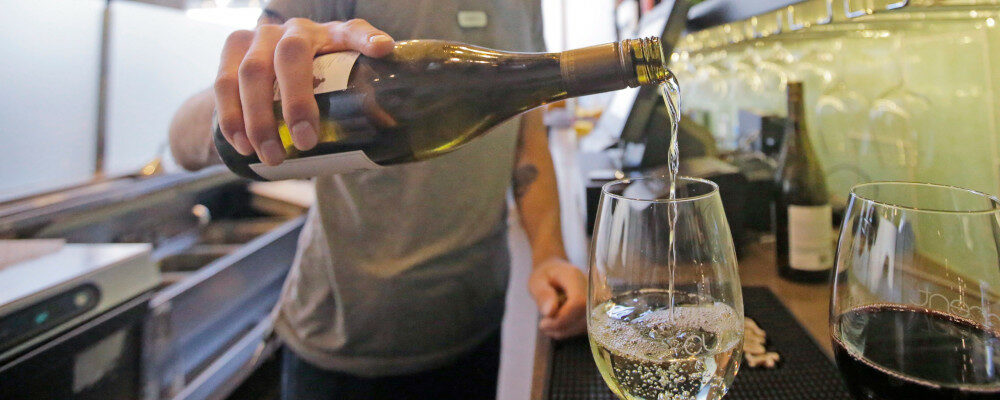Picpoul de Pinet is three things. It’s the name of a crisp French white wine, the single grape variety it’s made from, and the place where it’s grown and produced. Pronounced ‘peek-pool’, Picpoul hails from the Languedoc, historically the Pays d’Oc, or home of the Occidentals. For the purposes of wine production, the Languedoc can be geographically defined as the lands west of the Rhône River, east of the Corbières Mountains that climb north and northwesterly up from the Mediterranean shore.
At nine o’clock in the morning last week, I found myself facing 24 bottles of Appellation d’origins protégée Picpoul de Pinet. They were lined up on a table in the medieval vaulted ceiling function room of the Conseil Interprofessionnel des Vins du Languedoc, in the heart of the pretty cathedral town of Narbonne.
I am confident that the collection of bottles was the most Picpoul I had ever seen, not just in one place but likely in total. Picpoul de Pinet is hard to find on this side of the Atlantic. This is a shame because it’s a fun people-pleasing wine with an interesting story.
The bottles were part of a tasting, which I attended along with a few dozen members of the international wine press as the guest of the Conseil, or CIVL, a consortium of producers and other trade professionals that promote Languedoc wine. My flight, accommodation, and general well-being were looked after by CIVL, though I received no, nor agreed to any, editorial direction.
The row of two dozen bottles of Picpoul de Pinet was actually one of the smaller arrays of wine offered for tasting that morning. For instance, Corbières, a much bigger region, which makes white, rosé, and red wines, offered 73 bottles to taste. In all, there were 171 wines, from just five of the Languedoc’s dozen-odd appellations to test before noon. 1Yes, everyone was spitting, and the buckets had to be emptied regularly by a small cadre of sommeliers.
Overwhelmed by numbers and choice, the 24 slender bottles of Picpoul seemed like a manageable place to start. And not just for reasons of quantity: Picpoul is a consistently crisp and refreshing wine. One origin story for the name of the grape, though not enthusiastically encouraged by its makers, is that it means “lip stinger”. If one was going to have wine for breakfast, or at least as a first thing in the morning mouthwash, then it seemed like a good place to start.
Going back over my notes from the tasting, every wine had some quality of citrus fruit, most often dominated by lemon, and occasionally accompanied by green apple or a touch of white flower. A defining characteristic of Picpoul is that it retains high acidity, even though it is a late-ripening, warm-climate wine. The wines consistently, as the French say, brought water to the mouth.
20 of the 24 wines were from 2022, and the rest from 2021. Picpoul is made without much fuss and is made to be drunk young. Apart from the occasional experiment (see below), the Picpouliers (which is what the vigneron of the region call themselves) prefer stainless steel to wood. Like Muscadet from the Loire, producers who wish to add some complexity will keep their wines on their lees. Still, in Picpoul, simplicity is considered a virtue.
The Picpoul de Pinet region is small, with only 24 producers and just 1,400 hectares, or about 3,600 acres, with mostly sandy soil under vines. AOP production is limited to a coastal zone between the town of Pézenas and the port of Sète. The littoral is not on the Mediterranean proper but rather the L’Étange de Thau, which is the largest of the inland saltwater lagoons that characterize France’s Western Mediterranean shore.

The English wine writer Andrew Jefford lives nearby to the Picpoul zone and has made no secret of his fondness for the wine. He has written that one of the metaphysical pleasures drawn from a glass of it is the knowledge that all the terroir that could make it has been used up; there will be no more.
In fact, there will soon be less. A planned new route for a Train de Grand Vitesse (a.k.a. TGV) from Paris to Perpignan is planned to dissect the region from east to west, further limiting the production area. On top of which, Picpoul is one of the varieties of grapes blended into the locally made Noilly Prat Vermouth.
Another reason that Picpoul de Pinet is hard to find in Canada and the U.S. is the British. The United Kingdom imports and consumes a full 64 percent of all the Picpoul produced. British tourists began to holiday in the Languedoc in the 1980s and began to enjoy it with the local seafood at resort town restaurants. The story goes that one of them happened to be a wine buyer for a large supermarket chain who took a large order of what had been an obscure wine. One is more likely to find Picpoul on a store shelf or wine list in London than Paris.
The waters of the L’Étange de Thau are the main area of production for the Mediterranean oyster, and their beds can be seen from the shore vineyards and vice-versa. Smaller and saltier than their Atlantic cousins, they are said to be Picpoul’s perfect match. In-depth research undertaken by The Hub confirms that this is not false. But it might also suggest that Picpoul with any meaty white-fleshed seafood, like crudo, shrimp, or squid is also very good.
In a side room from the main tasting, I attended a seminar held by Katrina Muller MW, a local oenologist and winemaker originally from Chile. We were served some older vintage Picpoul, part of a program managed by the Syndicate AOP Picpoul de Pinet to encourage Picpouliers to experiment with wines meant to age a little. Wines that were three to five years old, and left longer on lees, showed honeyed notes, more apple, and sometimes the mediterranean herbal characteristic known as “garrigue“.
Like many lesser-known French wines, Picpoul de Pinet is easier to find in Quebec than elsewhere, but the occasional bottle gets off a boat before the St. Lawrence or makes it west of the Ottawa River. At retail, Picpoul should be between $15 to $25 in most cases, and correspondingly in the affordable zone of a wine list. In an ideal world, every French restaurant would have a Picpoul de Pinet by the glass. If you come by any, I recommend you give it a try, if only pour encourager les autres.




